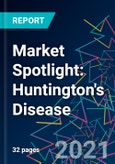Huntington’s disease (HD) is a rare disorder of the central nervous system (CNS) which causes the degeneration of nerve cells. It is an autosomal dominant disease characterized by involuntary choreatic movements, psychiatric and behavioral disturbances, and dementia. The mean age of symptom onset is 30-50 years. HD is caused by the presence of >40 cytosine-adenine-guanine (CAG) repeats within the Huntingtin gene. The length of the CAG repeats is inversely associated with the age of disease onset - the longer the repeat, the earlier the onset. In the case of juvenile HD (JHD), the length of the repeat is >55 and the disease’s symptoms are seen in patients aged < 20 years. Learning disabilities and behavioral disturbances are the first symptoms in patients with JHD.
Key Takeaways
Key Takeaways
- The publisher estimates that in 2019, there were 77,200 prevalent cases of Huntington’s disease (HD) in adults aged 30 years and older worldwide, and forecasts that number to increase to 87,700 prevalent cases by 2028.
- Northern America is estimated to have the highest disease prevalence (0.0073%), while Asia has the lowest prevalence (0.0004%).
- Teva’s Austedo and Bausch Health’s Xenazine, which target vesicular monamine transporters, are the only marketed drugs for HD. These drugs are administered via the oral route.
- The majority of industry-sponsored drugs in active clinical development for HD are in Phase II. Therapies in active clinical development for HD focus on targets such as huntingtin, vesicular monamine transporters, p38 MAP kinase, SIRT1, vasopressin receptors, dopamine 2 receptor, sigma-1 receptor, semaphorin 4D/CD100, NMDA glutamate receptor, PPAR delta, PPAR gamma, complement component 1q, and complement pathway. The majority of the pipeline drugs are administered via the oral route, with the remainder being intrathecal, intravenous, and intracerebral/cerebroventricular formulations.
- High-impact upcoming events for drugs in the HD space comprise topline Phase Ib/IIa trial results for WVE-120101, topline Phase I/II trial results for AMT-130, topline Phase IIa trial results for ANX-005, and topline Phase III trial results for Ingrezza and tominersen.
- The overall likelihood of approval of a Phase I neurodegenerative asset is 7.7%, and the average probability a drug advances from Phase III is 49.5%. Drugs, on average, take 11.1 years from Phase I to approval, compared to 9.8 years in the overall neurology space.
- The distribution of clinical trials across Phase I-IV indicates that the majority of trials for HD have been in the early and midphases of development, with 76% of trials in Phase I-II, and only 24% in Phase III-IV.
- The US has a substantial lead in the number of HD clinical trials globally, while the UK leads the major European markets. Clinical trial activity in the HD space is dominated by completed trials. Pfizer and Teva have the highest number of completed clinical trials for HD, with 14 trials each.
- Pfizer and Teva lead industry sponsors with the highest overall number of clinical trials for HD
Table of Contents
OVERVIEWKEY TAKEAWAYSEPIDEMIOLOGYMARKETED DRUGSPIPELINE DRUGSKEY UPCOMING EVENTSPROBABILITY OF SUCCESSREVENUE OPPORTUNITYAPPENDIX
DISEASE BACKGROUND
TREATMENT
RECENT EVENTS AND ANALYST OPINION
KEY REGULATORY EVENTS
CLINICAL TRIAL LANDSCAPE
BIBLIOGRAPHY
LIST OF FIGURES
LIST OF TABLES








